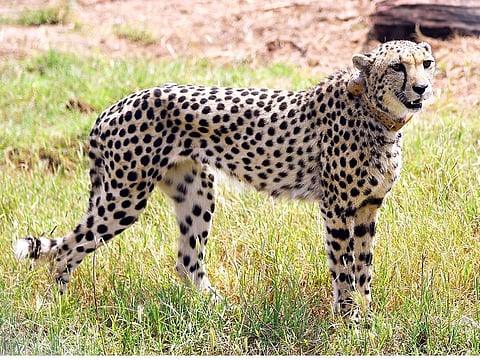India’s first home-born cheetah gives birth to five cubs in historic breakthrough
Born in 2023 and hand-reared after heat, Mukhi now ushers Project Cheetah into a new era

Dubai: In a landmark moment for India’s ambitious Cheetah Reintroduction Project, an India-born female cheetah, Mukhi, has given birth to five healthy cubs at Kuno National Park — the first-ever reproduction by a cheetah born on Indian soil.
Madhya Pradesh Chief Minister Dr Mohan Yadav called the development “a historic milestone” and “an unprecedented breakthrough”, saying the birth proves that reintroduced cheetahs are not just surviving, but thriving across generations.
Project Cheetah — key facts
Launched: 17 September 2022
Goal: Restore cheetahs to India after 70 years
Imported cheetahs: 20 (8 from Namibia, 12 from South Africa)
Cubs born in India: Over two dozen, including Mukhi’s new litter
Success indicator: First reproduction by an India-born cheetah (Mukhi)
Monitoring tools: Radio collars, drones, camera traps
Future sites: Gandhi Sagar Sanctuary, Shahgarh Landscape
India’s edge: World’s first intercontinental cheetah translocation project
Mukhi, just 33 months old, is now the first Indian-born cheetah to reproduce, marking a crucial validation for the world’s first intercontinental cheetah translocation effort launched by Prime Minister Narendra Modi in 2022.
Park officials confirmed that Mukhi and her cubs are in excellent health and are being monitored round the clock using radio collars and camera traps.
A story of survival to motherhood
Mukhi’s own journey has become a symbol of resilience. Born in March 2023 to Namibian cheetah Jwala, she was the sole survivor in a litter of four, after her siblings died during extreme heat. Hand-reared by Kuno staff after being abandoned by her mother, Mukhi has now delivered a remarkably large litter, boosting hopes for a genetically strong cheetah population.
Cheetahs around the world — at a glance
Scientific name: Acinonyx jubatus
Fastest land animal: Up to 110km/h
Global population: ~7,000 remaining in the wild
Historic range: Africa, Middle East, Iran, India
Current range: 90% restricted to southern and eastern Africa
Critically endangered population: Iran (only 10–12 Asiatic cheetahs left)
Primary threats: Habitat loss, conflict with livestock farmers, low genetic diversity
Average litter size: 3–4 cubs (Mukhi’s 5 is notably high)
Cheetahs extinct in India: 1952
Reintroduced: 2022 (Namibia & South Africa translocation)
Turning point for India’s wildlife restoration
Wildlife experts describe Mukhi’s litter as a “turning point”, signalling that cheetahs have adapted well to Indian landscapes and can establish a self-sustaining population.
Since the cheetah’s extinction in India in 1952, Project Cheetah has brought 8 cheetahs from Namibia and 12 from South Africa. Despite early deaths, more than two dozen cubs have been born in India, with survival rates higher than global averages.
With the birth of second-generation cheetahs like Mukhi’s litter, India is preparing to expand habitats to sites such as the Gandhi Sagar Sanctuary, strengthening long-term conservation prospects.
India, once home to the Asiatic cheetah, is now emerging as a global leader in bold wildlife restoration — and Mukhi’s five cubs stand as living proof.
Sign up for the Daily Briefing
Get the latest news and updates straight to your inbox




